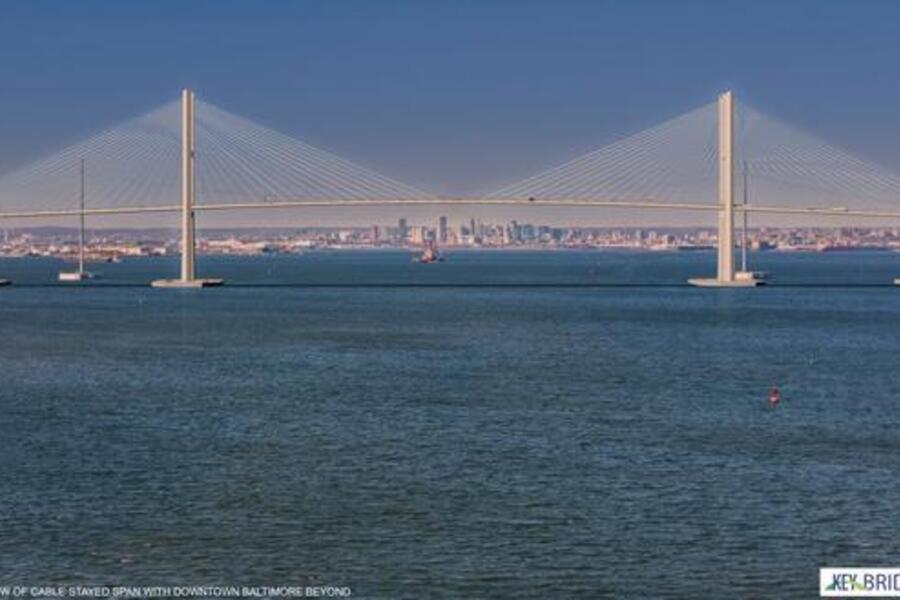Maryland Governor Wes Moore is poised to deliver his third State of the State address on Wednesday afternoon from the House Chamber at the Maryland State House. The governor is expected to outline his administration’s key plans and priorities for the state, including infrastructure projects, economic development, budget reforms, and public health strategies.
New Francis Scott Key Bridge Design Announced
Ahead of his address, Moore unveiled plans for a new Francis Scott Key Bridge on Tuesday. The previous bridge collapsed on March 26, 2024, when the cargo ship Dali lost power and crashed into it, tragically killing six workers and injuring one. The new bridge’s design, presented in collaboration with the Maryland Transportation Authority (MDTA), will honor the architectural tradition of the original structure while integrating modern safety and infrastructure standards.
“Our new bridge will use the best materials available and create thousands of jobs for Marylanders,” Moore stated. “We’re committed to building a structure that’s both durable and innovative.”
The project, estimated to cost $2 billion, began pre-construction in January 2025 and is scheduled for completion by fall 2028. The bridge will feature a cable-stay design, expanding the federal shipping channel from 700 to 1,000 feet in width and raising the structure’s base to 230 feet—an increase of 45 feet to accommodate larger ships. The roadway will maintain its current two-lane configuration in both directions.
“We’re focused on both quality and efficiency,” said Maryland Department of Transportation (MDOT) Secretary Paul Wiedefeld. “Time is a crucial factor as we rebuild this critical infrastructure.”
Maryland Faces $2.7 Billion Deficit
One of the major challenges Moore is expected to address is Maryland’s $2.7 billion budget deficit, the largest in two decades. The governor has introduced a fiscal strategy that combines $2 billion in spending cuts with targeted tax reforms. Under the plan, 66% of Marylanders—primarily middle-class families—would see tax reductions, while higher-income earners would face increases. Those earning over $500,000 annually will pay more, with the largest hikes affecting individuals making over $1 million.
“I inherited a structural deficit due to years of unsustainable spending,” Moore said, adding that the budget must reflect both fiscal responsibility and economic growth. The state’s constitution requires a balanced budget, with the final vote anticipated on April 1, 2025.
Planned investments include:
- $750 million for economic and workforce development initiatives, including $128.5 million for business growth.
- $27.5 million for a partnership with IonQ and the University of Maryland to promote quantum computing as part of the “Capital of Quantum” initiative.
- $25 million for the state’s “Sunny Day Fund” to attract new businesses.
- $15 million for new terminal development at Tradepoint Atlantic in Sparrow’s Point.
- $6 million for the Maryland Manufacturing 4.0 program.
Moore’s budget also maintains $122 million in local police protection funding, expands resources for the Department of Juvenile Services, and invests in public education, childcare, and job training programs.
Sharp Decline in Fatal Overdoses
Moore is expected to highlight a historic decrease in fatal overdoses in Maryland. Data from the state’s Overdose Data Dashboard indicates a 38% reduction in fatal overdoses in 2024, with 1,553 reported deaths compared to 2,511 in 2023.
“This decline is proof that our investments in behavioral health and substance use care are working,” Moore stated. “However, we still have more work to do. Too many of our loved ones are still being lost to preventable overdoses.”
The data reveals ongoing disparities in overdose fatalities. Black residents accounted for 44% of overdose deaths since 2022, with Black men over 55 experiencing the highest rate of increase. Additionally, overdose deaths among Hispanic residents under 25 have now surpassed those of both white and Black peers in the same age group.
Moore’s administration has focused on expanding access to addiction treatment and improving community-based mental health services. He emphasized the importance of continuing these efforts, saying, “We will not let up until we meet people where they are and connect them to the care they need.”
As Moore prepares for his State of the State address, his administration is prioritizing a balance between fiscal reform, infrastructure development, and social investment. The unveiling of the new Key Bridge, the aggressive budget strategy, and the decline in overdose deaths are seen as key indicators of Moore’s vision for a stronger Maryland.
Political analysts and community leaders will be closely monitoring the governor’s address to see how these initiatives will be implemented. For now, Moore’s proactive leadership continues to draw praise for tackling the state’s most pressing challenges head-on.
“The progress we’ve made is just the beginning,” Moore said. “We are building a future that all Marylanders can be proud of.”

